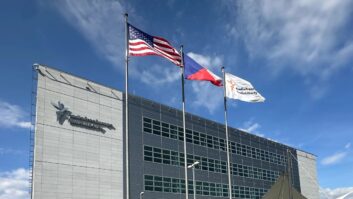In radio’s infancy, legend has it, evangelist Aimee Semple McPherson sent an angry telegram to Secretary of Commerce Herbert Hoover about her station, KFSG.
Hoover was sometimes called the “radio czar” because he was in charge of broadcasting between 1920 and 1926. The supposed 1920s telegram reportedly contained the phrase “please order your minions of Satan to leave my radio station alone.”

Kenneth G. Ormiston and Aimee Semple McPherson, 1924. Photo credit: Int’l Church of the Foursquare Gospel Archive For many years, I believed that this story was true. But now, after examining the facts closely, I believe this is another myth from radio’s earliest years, not unlike the commonly heard statement that KDKA was the first radio station in the world.
Such a telegram likely was never sent by McPherson. Hoover’s telling of the story is full of gaps.
My research has found no mention of this incident in any newspapers or popular radio magazines of the 1920s. Neither Hoover nor McPherson ever spoke or wrote about such an incident at the time. Hoover first told the story in a 1945 radio speech. He later wrote about it in Volume II of his memoirs in 1951. Hoover claimed that McPherson sent the alleged telegram after the Department of Commerce had warned her about her station, KFSG. Hoover said that KFSG had “wandered all over the wave band” causing interference to other Los Angeles stations. Hoover added that warnings about KFSG sticking to its own frequency did no good, so the radio inspector sealed up her station, taking it off the air.
Hoover never gave an exact date or year that this alleged incident took place. There are no reports of KFSG being taken off the air in the records of the Radio Service Bulletins published by the Department of Commerce at the time.
Noted radio historian Erik Barnouw accepted Hoover’s telegram story as fact, in his 1966 book “A Tower in Babel—A History of Broadcasting in the United States to 1933.” Since then, more than 50 books on radio history have repeated the McPherson-Hoover telegram story, quoting Hoover’s memoirs or Barnouw’s book. Most claim the alleged incident took place in 1924 or 1925, but none give an exact date for the telegram.
As far as KFSG causing interference to other stations, there is only one piece of evidence that shows that this part of the story is true. The district radio inspector for California, Col. J.F. Dillon, sent two letters to Mrs. McPherson within two weeks after KFSG’s first broadcast in February of 1924. Dillon said his office was receiving complaints about KFSG causing interference to reception of KHJ and KFI. Dillon believed the problem was not caused deliberately by KFSG’s equipment but the inferior, less selective radios made in 1924, such as crystal sets, in proximity to KFSG’s transmitter.
But KFSG was never closed down and taken off the air, as Hoover claimed. And KFSG’s excellent engineer, Kenneth G. Ormiston, worked hard to help Los Angeles-area radio fans who had interference problems. He also helped those who wanted to get better reception. Ormiston was technical editor of “Radio Doings” magazine and answered reader’s questions about radio on KFWB each week in 1925. Ormiston also helped get KFWB on the air in 1925, and in 1934 was in charge of boosting the power of KNX to 50,000 watts.
Notably, McPherson’s son, Dr. Rolf K. McPherson, shed further doubt in a 1994 letter to me before his death:
“This is one of the many rumors which have persisted through the years. Mother never attempted to defy the law, but always endeavored to comply with the rules. The statements you mention certainly were not typical of her way of doing things. I might explain that the equipment in those days was not always adequate, but the situations were cleared as quickly as they could be.”
It is difficult to prove a negative. But I believe interference was a common problem in early radio; I believe there are several gaps in Hoover’s story about the alleged telegram. I believe my research suggests that the incident never took place and that it is time to bury this story, or at least demand more evidence of its veracity.
But decide for yourself. I have posted my detailed essay about the myth on Jeff Miller’s History of American Broadcasting website at http://jeff560.tripod.com/kfsg2.html.
Since I started researching and writing about early Los Angeles radio history, I’ve found there is little reliable information available, but plenty of inaccurate or false information. I try to set history straight in my articles on early radio.
Jim Hilliker is a self-taught historian and former radio broadcaster of 25 years with a particular interest in the early history of Los Angeles radio. Comment on this or any story. Email [email protected].







